Gardening is one of the most rewarding hobbies you can take on. With patience, care, and a little planning, a bare patch of earth can be transformed into a flourishing space filled with vibrant flowers, fresh vegetables, and herbs that feed both body and soul.
The journey truly takes you from dirt to delight. Whether you’re new to gardening or looking to refine your skills, this detailed guide will walk you through every step of growing a thriving garden.
1. Start with Healthy Soil
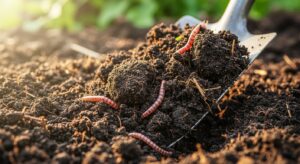
Soil is the lifeblood of your garden if it’s weak, your plants will struggle. Healthy soil provides nutrients, supports strong root systems, and retains moisture.
-
Test Your Soil: Use a simple home kit to check pH and nutrient balance. Most plants prefer a slightly acidic to neutral pH (6.0–7.0).
-
Enrich Organically: Add compost, aged manure, or leaf mulch to boost fertility and improve structure.
-
Encourage Earthworms: They naturally aerate soil and enrich it with castings.
-
Mulch Smartly: Apply straw, shredded leaves, or bark chips to lock in moisture and protect against erosion.
💡 Tip: Healthy soil feels crumbly in your hands, not sandy or compacted. If you invest in your soil, your plants will reward you tenfold.
2. Choose the Right Location
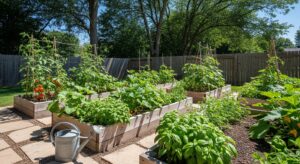
A thriving garden depends heavily on placement. Plants need the right mix of sun, water, and airflow.
-
Sunlight Matters: Most fruiting plants (like tomatoes and cucumbers) need 6–8 hours of full sun. Leafy greens thrive with 3–5 hours of partial shade.
-
Mind the Wind: Strong winds can damage plants. Plant near fences, walls, or hedges for natural protection.
-
Proximity to Water: Make sure your garden is close to a water source—lugging hoses across your yard quickly becomes tiring.
-
Accessibility: Place your garden where you’ll see it daily—out of sight often means out of mind.
💡 Tip: Observe your garden space throughout the day and across seasons. Summer sun patterns differ from spring and fall.
3. Select Plants Wisely
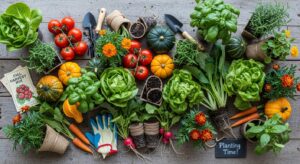
Your plant choices can make or break your gardening experience. Don’t pick plants just because they look pretty choose ones that suit your soil, climate, and lifestyle.
-
Vegetables for Beginners: Lettuce, radishes, carrots, zucchini, and cherry tomatoes are forgiving and high-yield.
-
Flower Favorites: Zinnias, marigolds, and sunflowers add instant cheer and attract pollinators.
-
Herbs for Everyday Use: Basil, parsley, mint, and rosemary are easy to grow and elevate meals.
-
Native Plants: These are adapted to your region, requiring less water and care while supporting local wildlife.
💡 Tip: Start small. Growing a few healthy plants is more rewarding than struggling with too many.
4. Master Watering Techniques

Water is essential, but how you deliver it makes a big difference. Overwatering can suffocate roots, while underwatering stunts growth.
-
Deep, Infrequent Watering: Water thoroughly so moisture penetrates 6–8 inches deep. This encourages deep root growth.
-
Timing is Key: Early morning watering reduces evaporation and allows leaves to dry, preventing disease.
-
Efficient Tools: Soaker hoses and drip irrigation systems target roots directly, conserving water.
-
Check the Soil: Stick your finger 2 inches deep if it’s dry, it’s time to water.
💡 Tip: Different plants have different needs. Group them by water requirements for easier care.
5. Practice Companion Planting
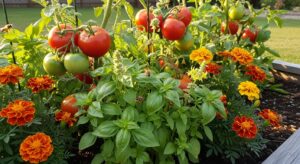
Companion planting is a natural way to reduce pests, improve soil, and boost growth. It turns your garden into a mini ecosystem.
-
Classic Pairs:
-
Tomatoes + Basil → Basil repels pests, tomatoes taste sweeter.
-
Corn + Beans + Squash (“Three Sisters”) → Beans fix nitrogen, corn provides support, squash shades soil.
-
Carrots + Onions → Each deters pests of the other.
-
-
Flower Helpers: Marigolds repel nematodes, while nasturtiums distract aphids from vegetables.
-
Avoid Bad Combos: Don’t plant onions near peas or beans they inhibit each other’s growth.
💡 Tip: Companion planting saves space and reduces the need for chemical pesticides.
6. Embrace Seasonal Planting
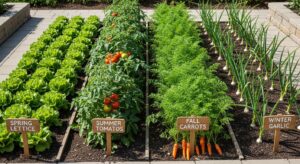
Gardens are dynamic, changing with the seasons. Plan for year-round productivity.
-
Spring: Lettuce, peas, radishes, tulips, daffodils.
-
Summer: Tomatoes, peppers, zucchini, sunflowers.
-
Fall: Kale, carrots, beets, chrysanthemums.
-
Winter (in mild climates): Garlic, onions, hardy greens like spinach.
-
Crop Rotation: Change what grows in each bed annually to avoid soil depletion and diseases.
💡 Tip: Keep a garden journal to track planting times and seasonal success.
7. Attract Pollinators and Beneficial Insects

Pollinators like bees, butterflies, and hummingbirds are essential for fruiting crops. Beneficial insects help control pests naturally.
-
Plant Pollinator-Friendly Flowers: Lavender, echinacea, sunflowers, and cosmos are nectar-rich.
-
Build Habitats: Add bee houses, butterfly gardens, and shallow water dishes.
-
Say No to Chemicals: Avoid synthetic pesticides that harm helpful insects.
-
Encourage Predators: Ladybugs, lacewings, and praying mantises keep pests in check.
💡 Tip: A buzzing garden is a healthy garden diversity of insects means balance.
8. Maintain with Care and Consistency
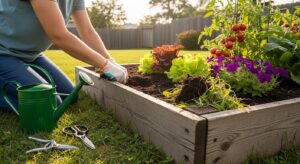
Gardens don’t thrive on neglect they require consistent attention.
-
Weeding: Pull weeds early before they establish deep roots.
-
Pruning & Deadheading: Removes dead growth, boosts air circulation, and encourages blooms.
-
Fertilizing: Feed plants with compost tea, fish emulsion, or organic fertilizers.
-
Observation: Check plants daily for early signs of stress, pests, or disease.
💡 Tip: A few minutes a day prevents hours of overwhelming work later.
9. Harvest at the Right Time

Harvesting correctly ensures maximum flavor, nutrition, and productivity.
-
Leafy Greens: Pick outer leaves regularly so the plant keeps producing.
-
Root Vegetables: Check size before pulling—carrots and beets taste best when tender.
-
Fruit Vegetables: Pick tomatoes and peppers fully colored; cucumbers and zucchini when young and tender.
-
Flowers: Cut blooms early in the morning for longer vase life.
💡 Tip: Overripe fruits left on plants can slow further production pick regularly!
10. Enjoy and Share the Rewards

A thriving garden doesn’t just feed you it brings joy, relaxation, and connection.
-
Cook with Fresh Ingredients: Turn your harvest into delicious meals.
-
Decorate with Blooms: Fresh flowers brighten any home.
-
Share the Abundance: Gift produce or flowers to friends, neighbors, or local food banks.
-
Relax in Your Garden: Add a bench or hammock to enjoy the sights and scents of your hard work.
💡 Tip: The true delight of gardening comes from sharing its beauty and bounty with others.
Final Thoughts
Turning bare dirt into a thriving, joyful garden takes time, effort, and care but the rewards are endless.
By starting with healthy soil, choosing the right plants, embracing smart techniques like companion planting, and tending your garden with consistency, you’ll create a flourishing outdoor space that truly goes from dirt to delight.
Whether you’re harvesting your first tomato, watching bees buzz among the flowers, or enjoying a peaceful evening in your green oasis, gardening reminds us of the beauty in patience and growth.